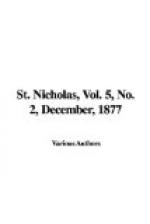A donkey listened sadly,
And said: “Confess
I must
That these are shallow people,
And terribly unjust.
“I’m bigger than the mock-bird,
And better bray than he,
Yet not a soul has uttered
A word in praise of me.”
THE FAMOUS HORSES OF VENICE.
BY MARY LLOYD.
No doubt you all know something of Venice, that wonderful and fairy-like city which seems to rise up out of the sea; with its bridges and gondolas; its marble palaces coming down to the water’s edge; its gay ladies and stately doges. What a magnificent pageant was that which took place every Ascension Day, when the doge and all his court sailed grandly out in the “Bucentaur,” or state galley, with gay colors flying, to the tune of lively music, and went through the oft-repeated ceremony of dropping a ring into the Adriatic, in token of marriage between the sea and Venice! This was a custom instituted as far back as 1177. The Venetians having espoused the cause of the pope, Alexander III., against the emperor, Frederic Barbarossa, gained a great victory over the imperial fleet, and the pope, in grateful remembrance of the event, presented the doge with the ring symbolizing the subjection of the Adriatic to Venice.
But one of the most wonderful things about Venice is that, with the exception of those I intend to tell you about, there are no horses there. How charming it must be, you think, when you want to visit a friend, to run down the marble steps of some old palace, step into a gondola, and glide swiftly and noiselessly away, instead of jolting and rumbling along over the cobble-stones! And then to come back by moonlight, and hear the low plash of the oar in the water, and the distant voices of the boatmen singing some love-sick song,—oh, it’s as good as a play!
Of course there are no carts in Venice; and the fish-man, the vegetable-man, the butcher, the baker, and the candlestick maker, all glide softly up in their boats to the kitchen door with their vendibles, and chaffer and haggle with the cook for half an hour, after the manner of market-men the world over.
So you see the little black-eyed Venetian boys and girls gaze on the brazen horses in St. Mark’s Square with as much wonder and curiosity as ours when we look upon a griffin or a unicorn.
[Illustration: THE HORSES OF ST. MARK’S.]
These horses—there are four of them—have quite a history of their own. They once formed part of a group made by a celebrated sculptor of antiquity, named Lysippus. He was of such acknowledged merit that he was one of the three included in the famous edict of Alexander, which gave to Apelles the sole right of painting his portrait, to Lysippus that of sculpturing his form in any style, and to Pyrgoteles that of engraving it upon precious stones.
Lysippus executed a group of twenty-five equestrian statues of the Macedonian horses that fell at the passage of the Granicus, and of this group the horses now at Venice formed a part. They were carried from Alexandria to Rome by Augustus, who placed them on his triumphal arch. Afterward Nero, Domitian and Trajan, successfully transferred them to arches of their own.




